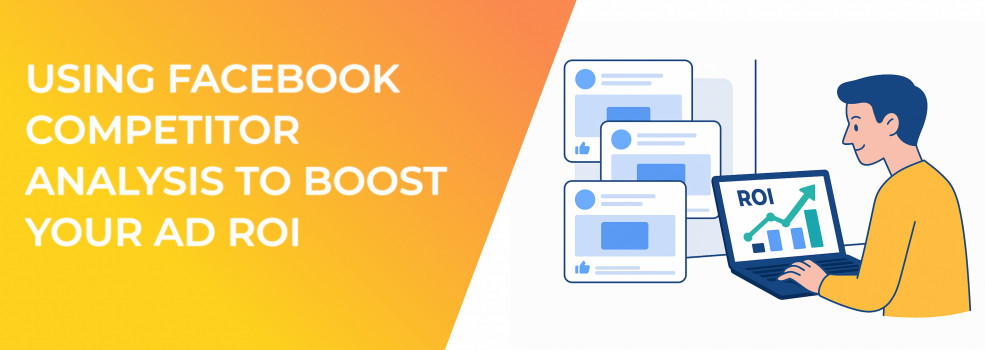Running profitable ads on Facebook is a balancing act of creativity, data, and timing. Consistent competitor research gives you a shortcut to campaigns that already resonate with the audiences you’re trying to reach. By folding competitor insights into your own media-buying playbook, you can tighten targeting, polish creative, and unlock stronger Facebook ad performance without costly guesswork.
When you monitor the market you uncover patterns such as offers that always pull, hooks that stop the scroll, and placements that stay cheap. These discoveries keep your brand ahead of price hikes and trend fatigue, while exposing funnel gaps and fresh opportunities for Facebook advertising best practices your team may have missed.
Why Competitor Analysis Matters
Before diving into numbers, remember that competitor tracking is a profit lever rather than a vanity exercise. It steers strategic decisions and prevents expensive blind spots. To ground your effort, here are four payoffs you capture right away:
-
It benchmarks your costs against the industry average CTR for display ads, telling you whether a dip is your creative or the market.
-
It keeps you current on real-world Facebook advertising price ranges and shifts in meta ads cost, so budgets stay realistic.
-
It surfaces proven messaging angles, letting you run targeted ads analysis that shortens creative testing cycles.
-
It reveals funnel gaps. If rivals rely on FB retargeting ads while you focus only on cold traffic, you are leaving revenue on the table.
When Facebook warns that an ad set may get zero results, follow this step-by-step fix before you relaunch.
Taken together, these benefits turn observation into measurable gains, keeping your Facebook ad optimization roadmap firmly tied to revenue.
Key Metrics to Track
Numbers guide every adjustment you make, so define success early. Think of these metrics as the heartbeat of your account:
Visualizing how your metrics stack up beside major competitors.
-
Click-through rate (CTR): Compare to good CTR on Facebook ads benchmarks to spot weak imagery or headlines.
-
Cost per thousand impressions (CPM): Monitor your Facebook advertising CPM alongside estimated competitor CPM to gauge auction pressure.
-
Cost per click (CPC): A rising CPC often signals creative fatigue, tight targeting, or a bid war you don’t need.
-
Conversion rate: Public data is scarce, but ad longevity and comment sentiment hint at how well a creative converts.
-
Frequency and freshness: Ads lingering too long may indicate learning limited Facebook ads, whereas evergreen ads running for weeks often flag repeatable success.
If your ads keep stalling in the learning phase, these tips on finishing the Facebook learning phase quickly will get them moving.
Track these numbers weekly and you’ll know exactly when to refresh creative or re-balance budget instead of reacting on instinct.
Where to Find Competitor Data
You no longer need shady scraping or huge budgets to spy responsibly. Reliable intel comes from the following sources:
-
Meta Ad Library: A free catalog of every active Meta ads campaign.
-
Spy tools such as PowerAdSpy, AdSpy, and BigSpy: Automate tracking ads on Facebook with filters for language, format, and engagement.
-
Business Manager: Overlay your own FB ads reporting with competitor timelines to spot clashes in audience interest.
-
Training resources and Meta ads training: Teach your team to interpret findings correctly.
-
Quick guides on how to find Ads Manager on Facebook: Streamline workflows so data collection never stalls.
For a deeper dive into competitive ad-spying tactics, skim our Ultimate Guide to Analyzing Your Facebook Competitors’ Ad Campaigns before you start your next research sprint.
With at least two data sources cross-checked, you’ll avoid basing strategy on outliers or outdated screenshots.
A Step-by-Step Competitor Analysis Workflow
Structure keeps research efficient and repeatable. Follow this six-step loop:
A repeatable loop to move from raw data to campaign tests.
-
Collect creatives. Screenshot standout videos, carousels, and statics, tagging each by format and funnel stage.
-
Log engagement signals. Record reactions, share counts, and comment themes to gauge sentiment.
-
Estimate spend. Multiply reach estimates by average Facebook advertising price to ballpark budgets.
-
Identify gaps. If rivals lean on user-generated content and you don’t, add it to your testing queue.
-
Map offers. Track discounts, bundles, and lead magnets so you can time promos strategically.
-
Prioritize tests. Score each idea by impact and effort, then funnel high-impact items into your sprint board for campaign budget optimization.
Finish by loading your findings into a living spreadsheet or dashboard. That database becomes the creative brief factory for every future launch.
Turning Insights Into Actionable Optimization
The real value appears once you transfer insights to live campaigns. Here’s how to apply what you learn:
-
Creative refresh: Mirror winning structures but inject unique visuals and benefits; watch Quality Ranking for your Facebook PPC ads.
-
Budget allocation: Shift spend toward audiences or placements rivals rely on until Meta ads cost climbs above target.
-
Audience layering: Combine interest clusters seen in competitor ads with first-party lookalikes to widen reach without sacrificing relevance. Need a quick refresher on building razor-sharp segments? Check out Facebook Ad Targeting 101 for the fundamentals.
-
Retargeting improvements: Not sure how to build a profitable remarketing loop? Here’s how to set up Facebook retargeting in minutes. Then replicate competitor sequencing to recover abandoned carts.
-
Rule-based safeguards: Set automated pauses if CPM spikes twenty-five percent over norm or if ads linger in learning limited Facebook ads for more than three days.
Apply these changes quickly to avoid analysis paralysis and you’ll see measurable lifts within weeks.
Advanced Strategies
After mastering the basics, level up with tactics that drive compound gains:
-
Creative swipe file: Store high-performing ads labeled by hook, emotion, and promise for rapid inspiration.
-
Budget stress tests: Temporarily raise bids to match top competitors’ CPM and measure incremental reach.
-
Cross-channel validation: Repurpose Facebook themes in Instagram Reels and Stories to reinforce brand recall.
-
Automated rules: Pause ads automatically when CPC rises too far above your average Meta ads cost, protecting ROI during auction spikes.
Scale budgets while protecting performance with advanced tactics.
When it’s time to push spend, follow the science of scaling Facebook ads so growth doesn’t tank performance.
Use these ideas sparingly and track their effect closely; advanced tweaks magnify gains but also magnify mistakes.
Measuring Success
Competitor-informed changes should show up quickly if you keep score honestly. Monitor the following outcomes:
-
CTR climbing toward or above good CTR on Facebook ads levels
-
CPM staying equal to or below competitor estimates despite higher spend
-
ROAS rising each quarter after adjustments to campaign budget optimization
-
Stable conversions and lower acquisition costs as fresh creatives enter rotation
Tie each win back to the specific insight that triggered it. This creates a feedback loop of evidence-based optimizations.
Conclusion
Competitor analysis turns the market into a classroom. By observing, testing, and refining, you gain a clear view of what prospects already respond to. Combine that knowledge with disciplined Facebook ad optimization and you will protect margins, outpace rising auction costs, and see sustainable improvements in return on ad spend. Start logging competitor ads today, commit to weekly reviews, and let the data guide your next breakthrough.

